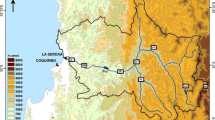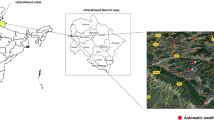Abstract
The air temperature is a critical factor in many societal challenges to protect human health and the environment. Moreover, a vital climatic parameter, the temperature has a direct impact on evaporation, frost, and snow melting. Temperature predictions are based mainly on numerical and statistical models. Sometimes it is a challenge to improve the weather forecast accuracy. The article aims to implement a weather prediction technique based on machine learning methods and approaches to improve the hourly air temperature prediction for up to 24 hours in the Ararat valley (Armenia). Due to intense heat and low relative humidity, the high temperatures and hot winds occur between 120 and 160 days per year in Ararat valley, as one of the aridest regions of Armenia. The approach utilizes the earth observation data received from several meteorological stations and the large satellite analysis-ready datasets at different frequencies and resolutions. The experiments have been conducted with multiple neural networks to forecast air temperatures for 24 hours that happened over the Ararat valley. The suggested model has 87.31% and 75.57% accuracies to predict the temperature for the next 3 and 24 hours, which is sufficient to be used alongside the current state-of-the-art techniques.








Similar content being viewed by others
References
Abhishek K, Singh M, Ghosh S, Anand A (2012) Weather forecasting model using artificial neural network
Anderson K, Ryan B, Sonntag W, Kavvada A, Friedl L (2017) Earth observation in service of the 2030 agenda for sustainable development. Geo-Spatial Information Science 20(2):77– 96
Asmaryan S, Muradyan V, Tepanosyan G, Hovsepyan A, Saghatelyan A, Astsatryan H, Grigoryan H, Abrahamyan R, Guigoz Y, Giuliani G (2019) Paving the way towards an armenian data cube. Data 4(3):117
Astsatryan H, Hayrapetyan A, Narsisian W, Asmaryan S, Saghatelyan A, Muradyan V, Giuliani G, Guigoz Y, Ray N (2015a) An interoperable cloud-based scientific gateway for ndvi time series analysis. Computer Standards & Interfaces 41:79–84
Astsatryan H, Sahakyan V, Shoukourian Y, Dongarra J, Cros PH, Dayde M, Oster P (2015b) Strengthening compute and data intensive capacities of Armenia. In: 2015 14th roedunet international conference-networking in education and research (RoEduNet NER). IEEE, pp 28–33
Astsatryan H, Shakhnazaryan A, Sahakyan V, Shoukourian Y, Kotroni V, Petrosyan Z, Abrahamyan R, Melkonyan H (2015c) Wrf-arw model for prediction of high temperatures in south and South East Regions of Armenia. In: 2015 IEEE 11th international conference on e-science. IEEE, pp 207–213
Astsatryan H, Narsisian W, Asmaryan S (2016) Swat hydrological model as a daas cloud service. Earth Science Informatics 9(3):401–407
Baboo SS, Shereef IK (2010) An efficient weather forecasting system using artificial neural network. International Journal of Environmental Science and Development 1(4):321
Box George E, Jenkins Gwilym M, Reinsel Gregory C (2015) Time series analysis: forecasting and control. Inc, Publication
Chapin FS, Sturm M, Serreze MC, McFadden JP, Key J, Lloyd AH, McGuire A, Rupp TS, Lynch AH, Schimel JP et al (2005) Role of land-surface changes in arctic summer warming. Science 310(5748):657–660
Dash P, Göttsche FM, Olesen FS, Fischer H (2001) Retrieval of land surface temperature and emissivity from satellite data: physics, theoretical limitations and current methods. Journal of the Indian Society of Remote Sensing 29(1-2):23
Durrieu S, Nelson RF (2013) Earth observation from space–the issue of environmental sustainability. Space Policy 29(4):238–250
El-Feghi I, Zubia Z, Abozgaya S (2014) Efficient weather forecasting using artificial neural network as function approximator. International Journal of Neural Networks and Advanced Applications 1(1):49–55
Erickson BJ, Korfiatis P, Akkus Z, Kline T, Philbrick K (2017) Toolkits and libraries for deep learning. Journal of Digital Imaging 30(4):400–405
Gardner MW, Dorling S (1998) Artificial neural networks (the multilayer perceptron) - a review of applications in the atmospheric sciences. Atmospheric Environment 32(14-15):2627–2636
Gevorgyan A (2017) Summertime wind climate in yerevan: valley wind systems. Clim Dyn 48 (5-6):1827–1840
Gevorgyan A, Melkonyan H, Abrahamyan R, Petrosyan Z, Shahnazaryan A, Astsatryan H, Sahakyan V, Shoukorian Y (2015) A persistent surface inversion event in Armenia as simulated by wrf model. In: 2015 Computer Science and Information Technologies (CSIT). IEEE, pp 105–110
Hecht-Nielsen R (1992) Theory of the backpropagation neural network. In: Neural networks for perception. Elsevier, pp 65–93
Holmstrom M, Liu D, Vo C (2016) Machine learning applied to weather forecasting. Stanford University, pp 2–4
Hyndman RJ, Athanasopoulos G (2018) Forecasting: principles and practice. OTexts
Ji L, Wang Z, Chen M, Fan S, Wang Y, Shen Z (2019) How much can ai techniques improve surface air temperature forecast? - a report from ai challenger 2018 global weather forecast contest. Journal of Meteorological Research 33(5):989–992
Jin M, Li J, Wang C, Shang R (2015) A practical split-window algorithm for retrieving land surface temperature from landsat-8 data and a case study of an urban area in China. Remote Sensing 7(4):4371–4390
Nayak R, Patheja P, Waoo AA (2012) An artificial neural network model for weather forecasting in Bhopal. In: IEEE-international conference on advances in engineering, science and management (ICAESM-2012). IEEE, pp 747–749
Papacharalampous G, Tyralis H, Koutsoyiannis D (2018) Predictability of monthly temperature and precipitation using automatic time series forecasting methods. Acta Geophysica 66(4):807–831
Rezaeian-Zadeh M, Zand-Parsa S, Abghari H, Zolghadr M, Singh VP (2012) Hourly air temperature driven using multi-layer perceptron and radial basis function networks in arid and semi-arid regions. Theor Appl Climatol 109(3-4):519–528
Skamarock WC, Klemp JB, Dudhia J, Gill DO, Barker DM, Duda MG, Huang XY, Wang W, Powers JG (2008) A description of the advanced research wrf version 3. In: NCAR Tech. Note NCAR/TN-475+ STR
Sobrino JA, Jiménez-Muñoz JC, Sòria G, Romaguera M, Guanter L, Moreno J, Plaza A, Martínez P (2008) Land surface emissivity retrieval from different vnir and tir sensors. IEEE Trans Geosci Remote Sens 46(2):316–327
Subbiah A, Narasimhan R, Shanmugasundaram J, Melkonyan H, Hovsepyan A (2013) Country report climate risk management in Armenia
Taylor SJ, Letham B (2018) Forecasting at scale. The American Statistician 72(1):37–45
The World Bank report TRoA (2012) Climate change and agriculture country note
Tomlinson CJ, Chapman L, Thornes JE, Baker C (2011) Remote sensing land surface temperature for meteorology and climatology: a review. Meteorol Appl 18(3):296–306
Ustaoglu B, Cigizoglu H, Karaca M (2008) Forecast of daily mean, maximum and minimum temperature time series by three artificial neural network methods. Meteorological Applications: A Journal of Forecasting, Practical Applications, Training Techniques and Modelling 15(4):431–445
Wan Z, Wang P, Li X (2004) Using modis land surface temperature and normalized difference vegetation index products for monitoring drought in the southern great plains, USA. International Journal of Remote Sensing 25(1):61–72
Wang L, Lu Y, Yao Y (2019) Comparison of three algorithms for the retrieval of land surface temperature from landsat 8 images. Sensors 19(22):5049
Xu HQ, Chen BQ (2004) Remote sensing of the urban heat island and its changes in Xiamen City of Se China. J Environ Sci 16(2):276–281
Yu X, Guo X, Wu Z (2014) Land surface temperature retrieval from landsat 8 tirs—comparison between radiative transfer equation-based method, split window algorithm and single channel method. Remote sensing 6(10):9829–9852
Zhang G, Patuwo BE, Hu MY (1998) Forecasting with artificial neural networks:: the state of the art. International journal of forecasting 14(1):35–62
Zhao S, Qin Q, Yang Y, Xiong Y, Qiu G (2009) Comparison of two split-window methods for retrieving land surface temperature from modis data. Journal of earth system science 118(4):345
Acknowledgements
The research was supported by the University of Geneva Leading House and the Philip Morris Armenia by the projects entitled “ADC4SD: Armenian Data Cube for Sustainable Development” and “Machine Learning to tackle weather and air pollution using DAtasets of satellite imagery and digiTAl models”.
Author information
Authors and Affiliations
Corresponding author
Additional information
Communicated by: H. Babaie
Publisher’s note
Springer Nature remains neutral with regard to jurisdictional claims in published maps and institutional affiliations.
Rights and permissions
About this article
Cite this article
Astsatryan, H., Grigoryan, H., Poghosyan, A. et al. Air temperature forecasting using artificial neural network for Ararat valley. Earth Sci Inform 14, 711–722 (2021). https://doi.org/10.1007/s12145-021-00583-9
Received:
Accepted:
Published:
Issue Date:
DOI: https://doi.org/10.1007/s12145-021-00583-9




